Analyzing Effective Reading and Writing Strategies for Students
VerifiedAdded on 2020/10/23
|9
|2429
|207
Essay
AI Summary
This essay delves into the crucial role of teachers in implementing effective reading and writing strategies to enhance student learning, particularly within the primary education context. It examines two primary reading strategies: shared reading and guided reading, detailing their strengths and limitations. Shared reading is praised for fostering interactive learning and fluency, while guided reading is highlighted for its ability to provide tailored support to small groups. The essay also explores writing strategies, including modelled writing and shared writing, discussing how these approaches support student skill development. Modelled writing emphasizes teacher demonstration of the writing process, and shared writing involves collaborative composition between teacher and students. The conclusion reinforces the significance of these strategies in fostering student literacy and the development of essential skills. The essay references key educational research to support its arguments, providing a comprehensive overview of effective teaching practices.
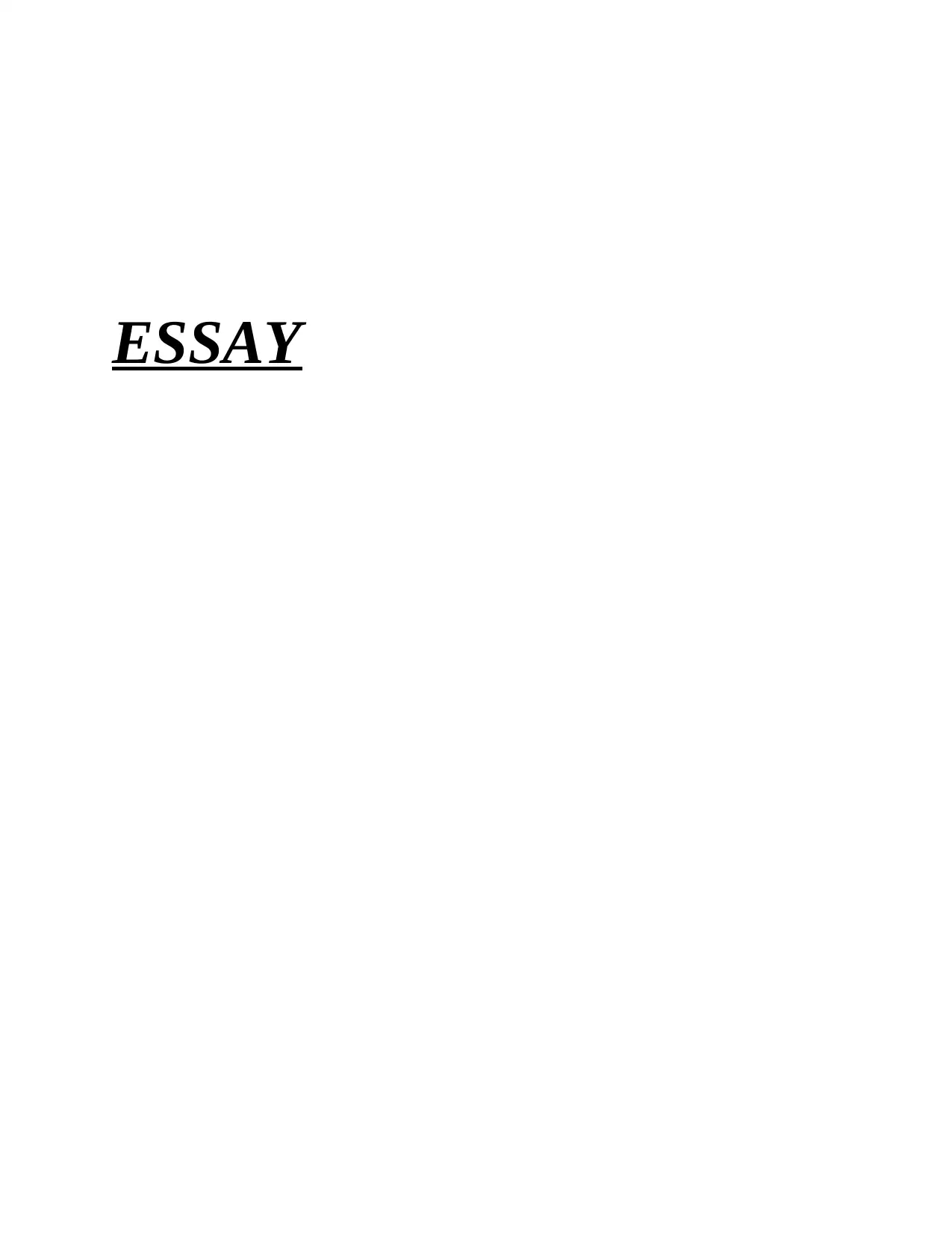
ESSAY
Paraphrase This Document
Need a fresh take? Get an instant paraphrase of this document with our AI Paraphraser
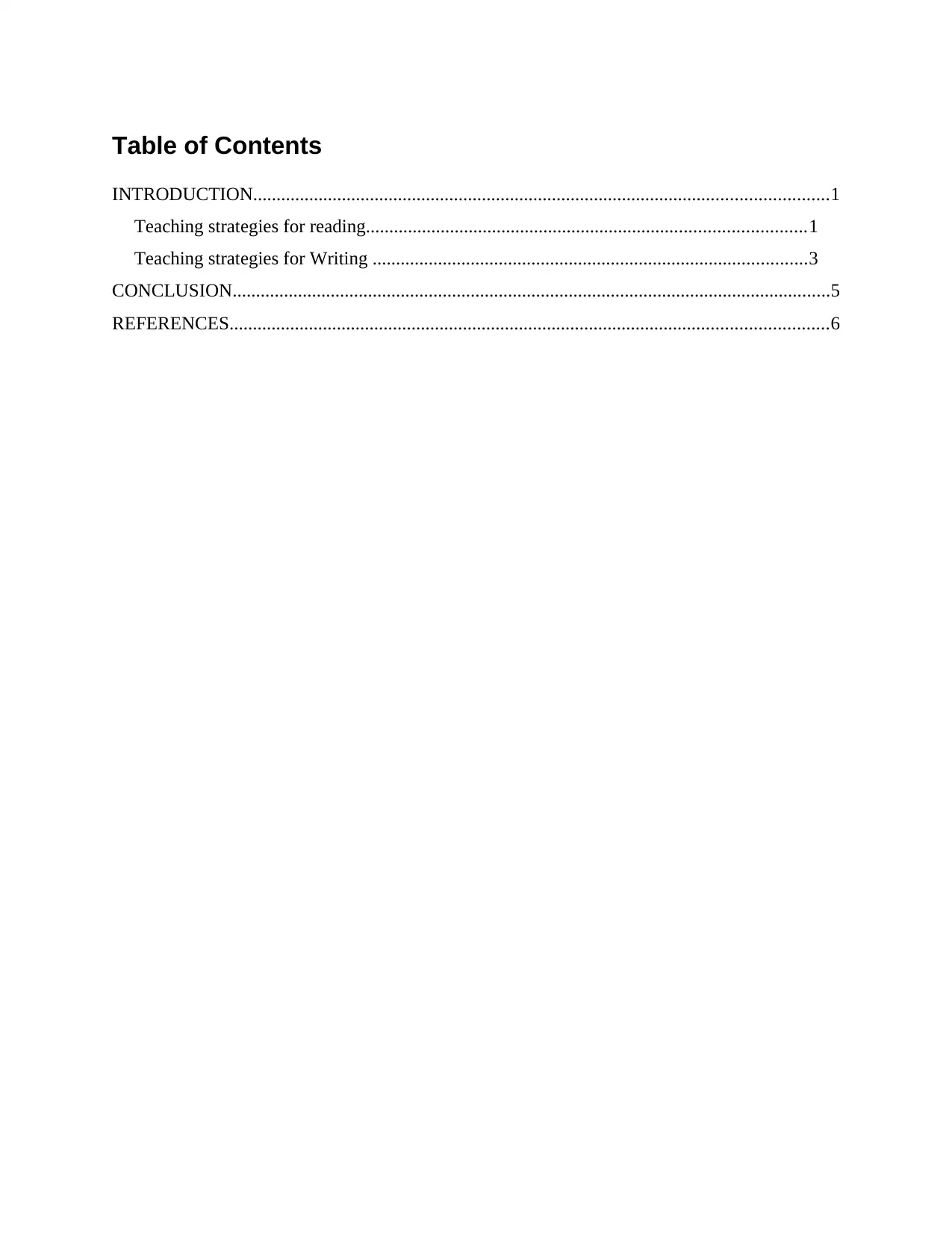
Table of Contents
INTRODUCTION...........................................................................................................................1
Teaching strategies for reading..............................................................................................1
Teaching strategies for Writing .............................................................................................3
CONCLUSION................................................................................................................................5
REFERENCES................................................................................................................................6
INTRODUCTION...........................................................................................................................1
Teaching strategies for reading..............................................................................................1
Teaching strategies for Writing .............................................................................................3
CONCLUSION................................................................................................................................5
REFERENCES................................................................................................................................6
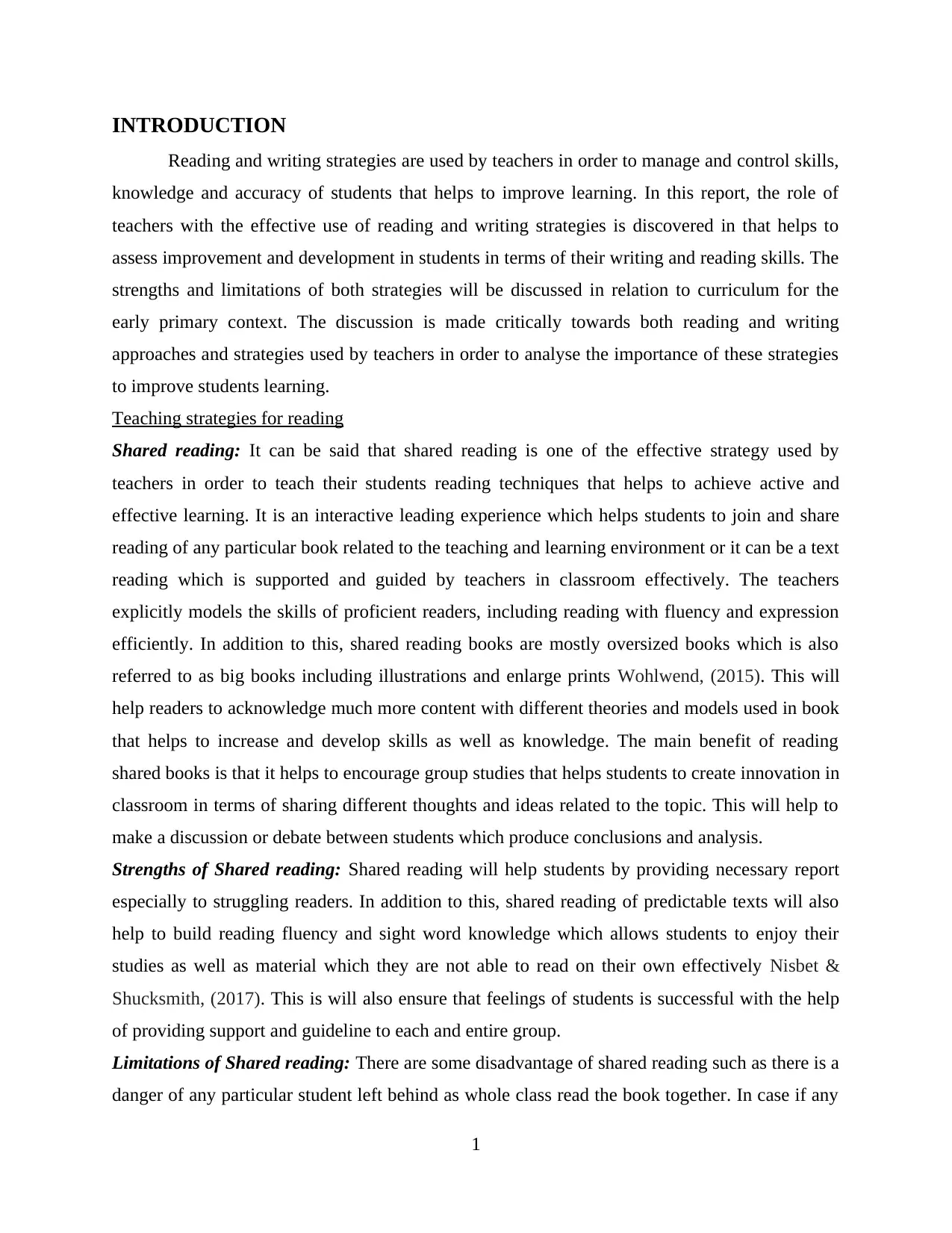
INTRODUCTION
Reading and writing strategies are used by teachers in order to manage and control skills,
knowledge and accuracy of students that helps to improve learning. In this report, the role of
teachers with the effective use of reading and writing strategies is discovered in that helps to
assess improvement and development in students in terms of their writing and reading skills. The
strengths and limitations of both strategies will be discussed in relation to curriculum for the
early primary context. The discussion is made critically towards both reading and writing
approaches and strategies used by teachers in order to analyse the importance of these strategies
to improve students learning.
Teaching strategies for reading
Shared reading: It can be said that shared reading is one of the effective strategy used by
teachers in order to teach their students reading techniques that helps to achieve active and
effective learning. It is an interactive leading experience which helps students to join and share
reading of any particular book related to the teaching and learning environment or it can be a text
reading which is supported and guided by teachers in classroom effectively. The teachers
explicitly models the skills of proficient readers, including reading with fluency and expression
efficiently. In addition to this, shared reading books are mostly oversized books which is also
referred to as big books including illustrations and enlarge prints Wohlwend, (2015). This will
help readers to acknowledge much more content with different theories and models used in book
that helps to increase and develop skills as well as knowledge. The main benefit of reading
shared books is that it helps to encourage group studies that helps students to create innovation in
classroom in terms of sharing different thoughts and ideas related to the topic. This will help to
make a discussion or debate between students which produce conclusions and analysis.
Strengths of Shared reading: Shared reading will help students by providing necessary report
especially to struggling readers. In addition to this, shared reading of predictable texts will also
help to build reading fluency and sight word knowledge which allows students to enjoy their
studies as well as material which they are not able to read on their own effectively Nisbet &
Shucksmith, (2017). This is will also ensure that feelings of students is successful with the help
of providing support and guideline to each and entire group.
Limitations of Shared reading: There are some disadvantage of shared reading such as there is a
danger of any particular student left behind as whole class read the book together. In case if any
1
Reading and writing strategies are used by teachers in order to manage and control skills,
knowledge and accuracy of students that helps to improve learning. In this report, the role of
teachers with the effective use of reading and writing strategies is discovered in that helps to
assess improvement and development in students in terms of their writing and reading skills. The
strengths and limitations of both strategies will be discussed in relation to curriculum for the
early primary context. The discussion is made critically towards both reading and writing
approaches and strategies used by teachers in order to analyse the importance of these strategies
to improve students learning.
Teaching strategies for reading
Shared reading: It can be said that shared reading is one of the effective strategy used by
teachers in order to teach their students reading techniques that helps to achieve active and
effective learning. It is an interactive leading experience which helps students to join and share
reading of any particular book related to the teaching and learning environment or it can be a text
reading which is supported and guided by teachers in classroom effectively. The teachers
explicitly models the skills of proficient readers, including reading with fluency and expression
efficiently. In addition to this, shared reading books are mostly oversized books which is also
referred to as big books including illustrations and enlarge prints Wohlwend, (2015). This will
help readers to acknowledge much more content with different theories and models used in book
that helps to increase and develop skills as well as knowledge. The main benefit of reading
shared books is that it helps to encourage group studies that helps students to create innovation in
classroom in terms of sharing different thoughts and ideas related to the topic. This will help to
make a discussion or debate between students which produce conclusions and analysis.
Strengths of Shared reading: Shared reading will help students by providing necessary report
especially to struggling readers. In addition to this, shared reading of predictable texts will also
help to build reading fluency and sight word knowledge which allows students to enjoy their
studies as well as material which they are not able to read on their own effectively Nisbet &
Shucksmith, (2017). This is will also ensure that feelings of students is successful with the help
of providing support and guideline to each and entire group.
Limitations of Shared reading: There are some disadvantage of shared reading such as there is a
danger of any particular student left behind as whole class read the book together. In case if any
1
⊘ This is a preview!⊘
Do you want full access?
Subscribe today to unlock all pages.

Trusted by 1+ million students worldwide
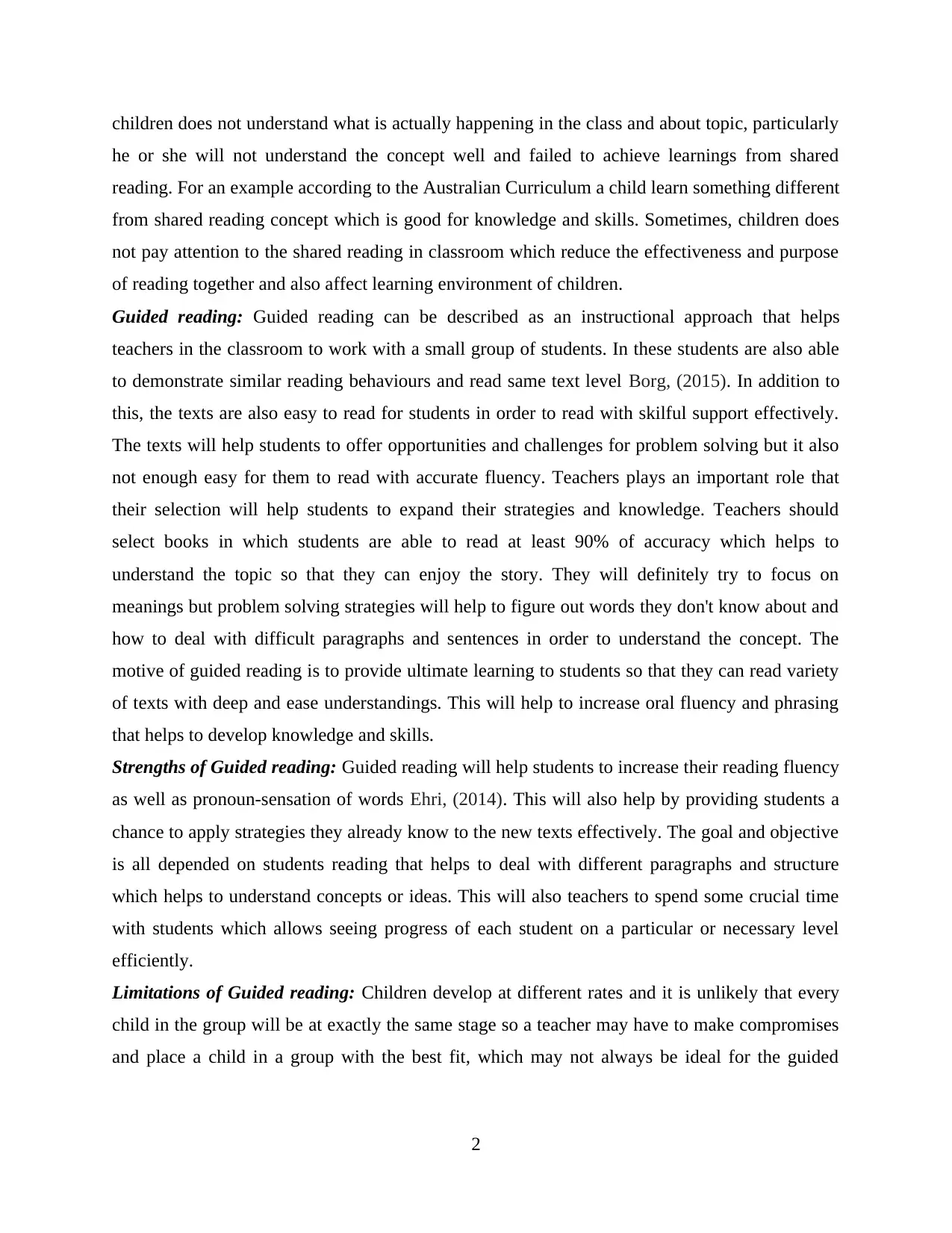
children does not understand what is actually happening in the class and about topic, particularly
he or she will not understand the concept well and failed to achieve learnings from shared
reading. For an example according to the Australian Curriculum a child learn something different
from shared reading concept which is good for knowledge and skills. Sometimes, children does
not pay attention to the shared reading in classroom which reduce the effectiveness and purpose
of reading together and also affect learning environment of children.
Guided reading: Guided reading can be described as an instructional approach that helps
teachers in the classroom to work with a small group of students. In these students are also able
to demonstrate similar reading behaviours and read same text level Borg, (2015). In addition to
this, the texts are also easy to read for students in order to read with skilful support effectively.
The texts will help students to offer opportunities and challenges for problem solving but it also
not enough easy for them to read with accurate fluency. Teachers plays an important role that
their selection will help students to expand their strategies and knowledge. Teachers should
select books in which students are able to read at least 90% of accuracy which helps to
understand the topic so that they can enjoy the story. They will definitely try to focus on
meanings but problem solving strategies will help to figure out words they don't know about and
how to deal with difficult paragraphs and sentences in order to understand the concept. The
motive of guided reading is to provide ultimate learning to students so that they can read variety
of texts with deep and ease understandings. This will help to increase oral fluency and phrasing
that helps to develop knowledge and skills.
Strengths of Guided reading: Guided reading will help students to increase their reading fluency
as well as pronoun-sensation of words Ehri, (2014). This will also help by providing students a
chance to apply strategies they already know to the new texts effectively. The goal and objective
is all depended on students reading that helps to deal with different paragraphs and structure
which helps to understand concepts or ideas. This will also teachers to spend some crucial time
with students which allows seeing progress of each student on a particular or necessary level
efficiently.
Limitations of Guided reading: Children develop at different rates and it is unlikely that every
child in the group will be at exactly the same stage so a teacher may have to make compromises
and place a child in a group with the best fit, which may not always be ideal for the guided
2
he or she will not understand the concept well and failed to achieve learnings from shared
reading. For an example according to the Australian Curriculum a child learn something different
from shared reading concept which is good for knowledge and skills. Sometimes, children does
not pay attention to the shared reading in classroom which reduce the effectiveness and purpose
of reading together and also affect learning environment of children.
Guided reading: Guided reading can be described as an instructional approach that helps
teachers in the classroom to work with a small group of students. In these students are also able
to demonstrate similar reading behaviours and read same text level Borg, (2015). In addition to
this, the texts are also easy to read for students in order to read with skilful support effectively.
The texts will help students to offer opportunities and challenges for problem solving but it also
not enough easy for them to read with accurate fluency. Teachers plays an important role that
their selection will help students to expand their strategies and knowledge. Teachers should
select books in which students are able to read at least 90% of accuracy which helps to
understand the topic so that they can enjoy the story. They will definitely try to focus on
meanings but problem solving strategies will help to figure out words they don't know about and
how to deal with difficult paragraphs and sentences in order to understand the concept. The
motive of guided reading is to provide ultimate learning to students so that they can read variety
of texts with deep and ease understandings. This will help to increase oral fluency and phrasing
that helps to develop knowledge and skills.
Strengths of Guided reading: Guided reading will help students to increase their reading fluency
as well as pronoun-sensation of words Ehri, (2014). This will also help by providing students a
chance to apply strategies they already know to the new texts effectively. The goal and objective
is all depended on students reading that helps to deal with different paragraphs and structure
which helps to understand concepts or ideas. This will also teachers to spend some crucial time
with students which allows seeing progress of each student on a particular or necessary level
efficiently.
Limitations of Guided reading: Children develop at different rates and it is unlikely that every
child in the group will be at exactly the same stage so a teacher may have to make compromises
and place a child in a group with the best fit, which may not always be ideal for the guided
2
Paraphrase This Document
Need a fresh take? Get an instant paraphrase of this document with our AI Paraphraser
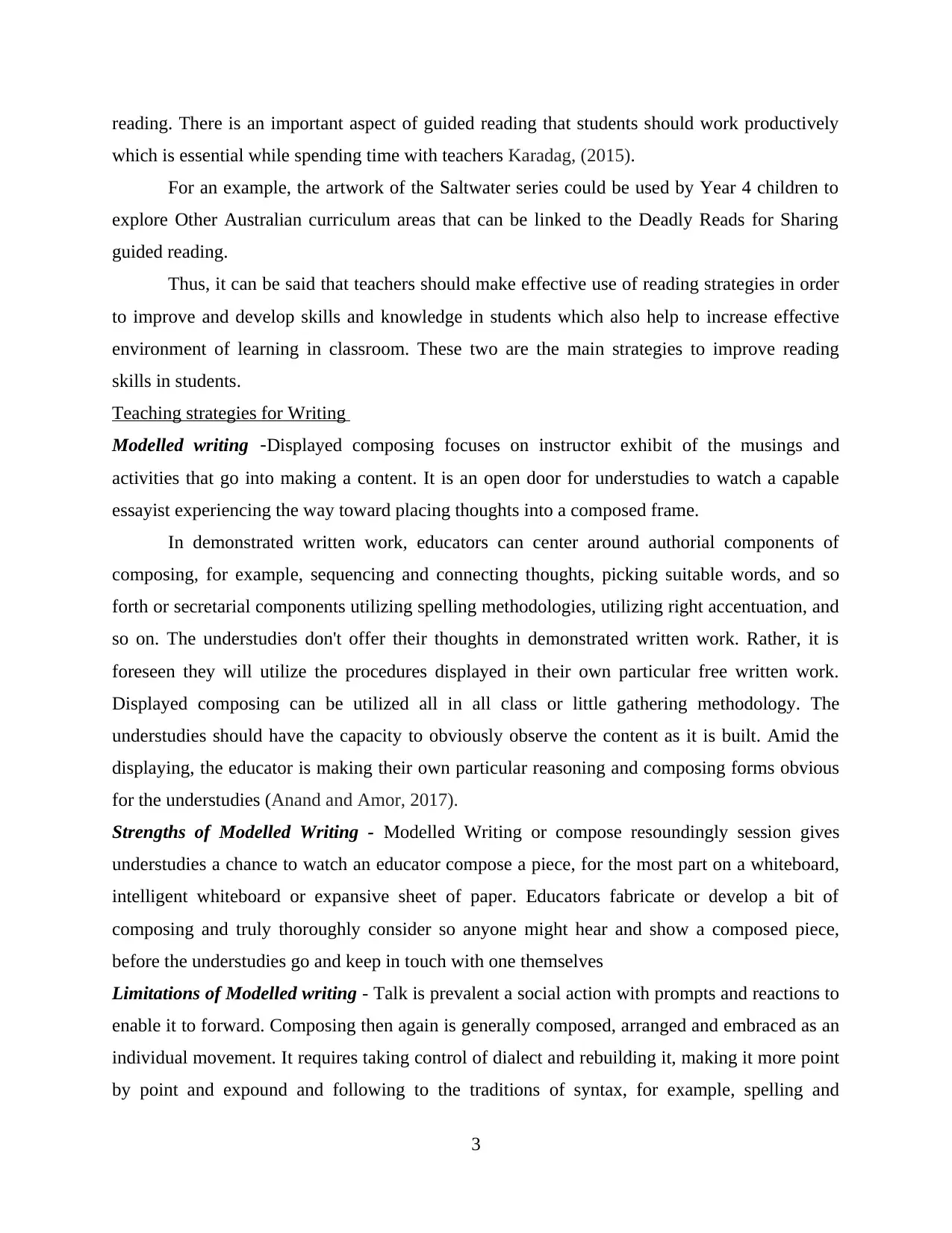
reading. There is an important aspect of guided reading that students should work productively
which is essential while spending time with teachers Karadag, (2015).
For an example, the artwork of the Saltwater series could be used by Year 4 children to
explore Other Australian curriculum areas that can be linked to the Deadly Reads for Sharing
guided reading.
Thus, it can be said that teachers should make effective use of reading strategies in order
to improve and develop skills and knowledge in students which also help to increase effective
environment of learning in classroom. These two are the main strategies to improve reading
skills in students.
Teaching strategies for Writing
Modelled writing -Displayed composing focuses on instructor exhibit of the musings and
activities that go into making a content. It is an open door for understudies to watch a capable
essayist experiencing the way toward placing thoughts into a composed frame.
In demonstrated written work, educators can center around authorial components of
composing, for example, sequencing and connecting thoughts, picking suitable words, and so
forth or secretarial components utilizing spelling methodologies, utilizing right accentuation, and
so on. The understudies don't offer their thoughts in demonstrated written work. Rather, it is
foreseen they will utilize the procedures displayed in their own particular free written work.
Displayed composing can be utilized all in all class or little gathering methodology. The
understudies should have the capacity to obviously observe the content as it is built. Amid the
displaying, the educator is making their own particular reasoning and composing forms obvious
for the understudies (Anand and Amor, 2017).
Strengths of Modelled Writing - Modelled Writing or compose resoundingly session gives
understudies a chance to watch an educator compose a piece, for the most part on a whiteboard,
intelligent whiteboard or expansive sheet of paper. Educators fabricate or develop a bit of
composing and truly thoroughly consider so anyone might hear and show a composed piece,
before the understudies go and keep in touch with one themselves
Limitations of Modelled writing - Talk is prevalent a social action with prompts and reactions to
enable it to forward. Composing then again is generally composed, arranged and embraced as an
individual movement. It requires taking control of dialect and rebuilding it, making it more point
by point and expound and following to the traditions of syntax, for example, spelling and
3
which is essential while spending time with teachers Karadag, (2015).
For an example, the artwork of the Saltwater series could be used by Year 4 children to
explore Other Australian curriculum areas that can be linked to the Deadly Reads for Sharing
guided reading.
Thus, it can be said that teachers should make effective use of reading strategies in order
to improve and develop skills and knowledge in students which also help to increase effective
environment of learning in classroom. These two are the main strategies to improve reading
skills in students.
Teaching strategies for Writing
Modelled writing -Displayed composing focuses on instructor exhibit of the musings and
activities that go into making a content. It is an open door for understudies to watch a capable
essayist experiencing the way toward placing thoughts into a composed frame.
In demonstrated written work, educators can center around authorial components of
composing, for example, sequencing and connecting thoughts, picking suitable words, and so
forth or secretarial components utilizing spelling methodologies, utilizing right accentuation, and
so on. The understudies don't offer their thoughts in demonstrated written work. Rather, it is
foreseen they will utilize the procedures displayed in their own particular free written work.
Displayed composing can be utilized all in all class or little gathering methodology. The
understudies should have the capacity to obviously observe the content as it is built. Amid the
displaying, the educator is making their own particular reasoning and composing forms obvious
for the understudies (Anand and Amor, 2017).
Strengths of Modelled Writing - Modelled Writing or compose resoundingly session gives
understudies a chance to watch an educator compose a piece, for the most part on a whiteboard,
intelligent whiteboard or expansive sheet of paper. Educators fabricate or develop a bit of
composing and truly thoroughly consider so anyone might hear and show a composed piece,
before the understudies go and keep in touch with one themselves
Limitations of Modelled writing - Talk is prevalent a social action with prompts and reactions to
enable it to forward. Composing then again is generally composed, arranged and embraced as an
individual movement. It requires taking control of dialect and rebuilding it, making it more point
by point and expound and following to the traditions of syntax, for example, spelling and
3
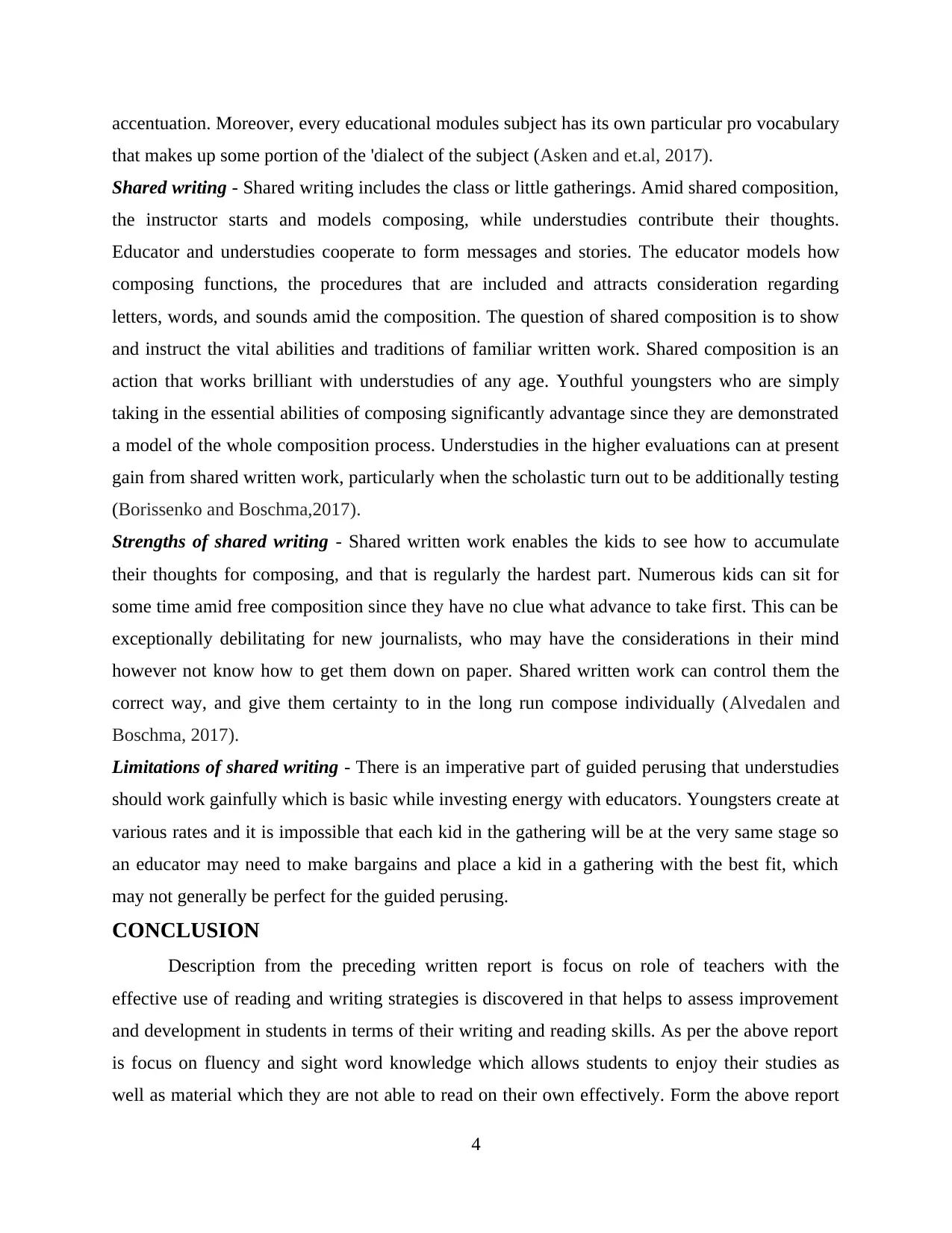
accentuation. Moreover, every educational modules subject has its own particular pro vocabulary
that makes up some portion of the 'dialect of the subject (Asken and et.al, 2017).
Shared writing - Shared writing includes the class or little gatherings. Amid shared composition,
the instructor starts and models composing, while understudies contribute their thoughts.
Educator and understudies cooperate to form messages and stories. The educator models how
composing functions, the procedures that are included and attracts consideration regarding
letters, words, and sounds amid the composition. The question of shared composition is to show
and instruct the vital abilities and traditions of familiar written work. Shared composition is an
action that works brilliant with understudies of any age. Youthful youngsters who are simply
taking in the essential abilities of composing significantly advantage since they are demonstrated
a model of the whole composition process. Understudies in the higher evaluations can at present
gain from shared written work, particularly when the scholastic turn out to be additionally testing
(Borissenko and Boschma,2017).
Strengths of shared writing - Shared written work enables the kids to see how to accumulate
their thoughts for composing, and that is regularly the hardest part. Numerous kids can sit for
some time amid free composition since they have no clue what advance to take first. This can be
exceptionally debilitating for new journalists, who may have the considerations in their mind
however not know how to get them down on paper. Shared written work can control them the
correct way, and give them certainty to in the long run compose individually (Alvedalen and
Boschma, 2017).
Limitations of shared writing - There is an imperative part of guided perusing that understudies
should work gainfully which is basic while investing energy with educators. Youngsters create at
various rates and it is impossible that each kid in the gathering will be at the very same stage so
an educator may need to make bargains and place a kid in a gathering with the best fit, which
may not generally be perfect for the guided perusing.
CONCLUSION
Description from the preceding written report is focus on role of teachers with the
effective use of reading and writing strategies is discovered in that helps to assess improvement
and development in students in terms of their writing and reading skills. As per the above report
is focus on fluency and sight word knowledge which allows students to enjoy their studies as
well as material which they are not able to read on their own effectively. Form the above report
4
that makes up some portion of the 'dialect of the subject (Asken and et.al, 2017).
Shared writing - Shared writing includes the class or little gatherings. Amid shared composition,
the instructor starts and models composing, while understudies contribute their thoughts.
Educator and understudies cooperate to form messages and stories. The educator models how
composing functions, the procedures that are included and attracts consideration regarding
letters, words, and sounds amid the composition. The question of shared composition is to show
and instruct the vital abilities and traditions of familiar written work. Shared composition is an
action that works brilliant with understudies of any age. Youthful youngsters who are simply
taking in the essential abilities of composing significantly advantage since they are demonstrated
a model of the whole composition process. Understudies in the higher evaluations can at present
gain from shared written work, particularly when the scholastic turn out to be additionally testing
(Borissenko and Boschma,2017).
Strengths of shared writing - Shared written work enables the kids to see how to accumulate
their thoughts for composing, and that is regularly the hardest part. Numerous kids can sit for
some time amid free composition since they have no clue what advance to take first. This can be
exceptionally debilitating for new journalists, who may have the considerations in their mind
however not know how to get them down on paper. Shared written work can control them the
correct way, and give them certainty to in the long run compose individually (Alvedalen and
Boschma, 2017).
Limitations of shared writing - There is an imperative part of guided perusing that understudies
should work gainfully which is basic while investing energy with educators. Youngsters create at
various rates and it is impossible that each kid in the gathering will be at the very same stage so
an educator may need to make bargains and place a kid in a gathering with the best fit, which
may not generally be perfect for the guided perusing.
CONCLUSION
Description from the preceding written report is focus on role of teachers with the
effective use of reading and writing strategies is discovered in that helps to assess improvement
and development in students in terms of their writing and reading skills. As per the above report
is focus on fluency and sight word knowledge which allows students to enjoy their studies as
well as material which they are not able to read on their own effectively. Form the above report
4
⊘ This is a preview!⊘
Do you want full access?
Subscribe today to unlock all pages.

Trusted by 1+ million students worldwide
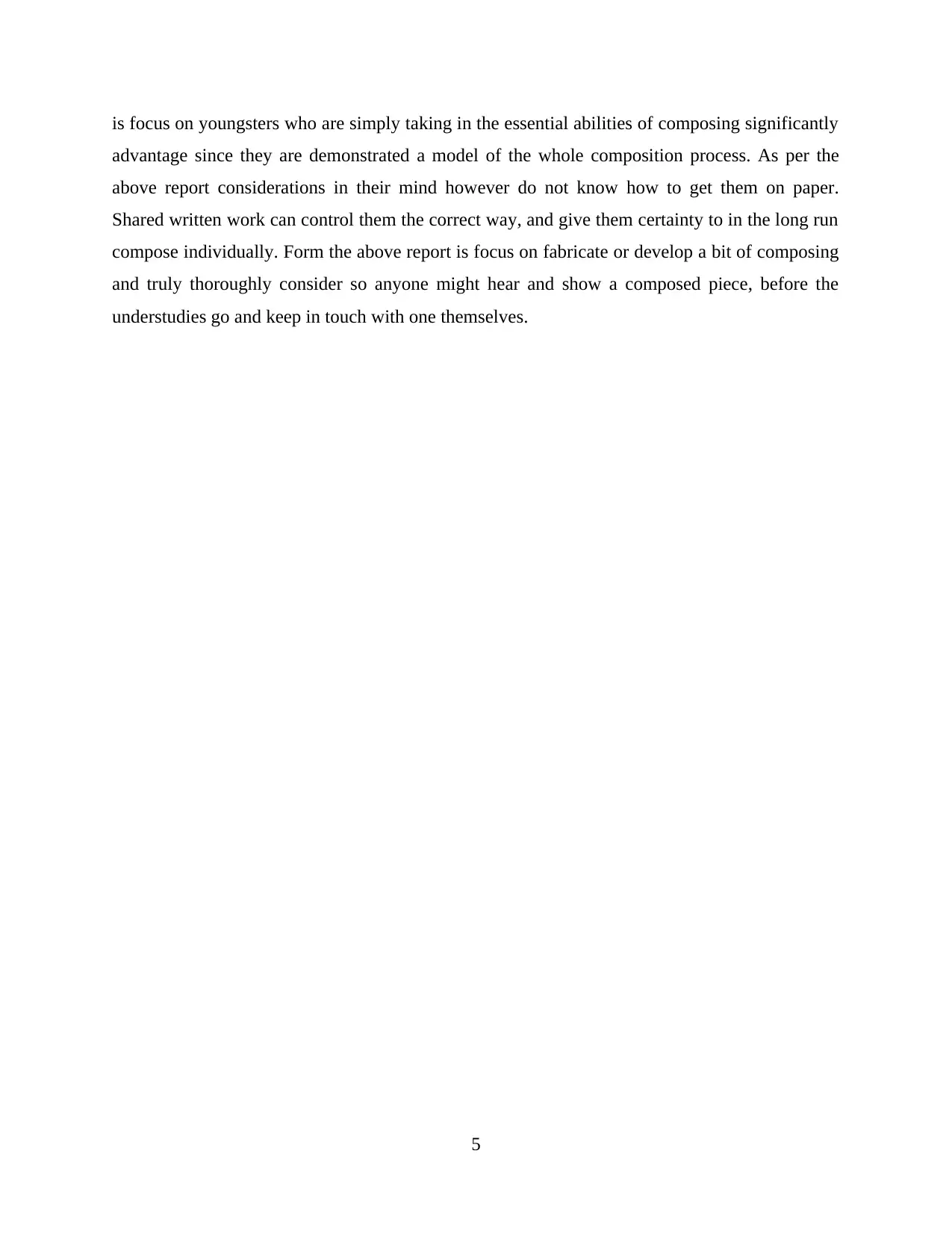
is focus on youngsters who are simply taking in the essential abilities of composing significantly
advantage since they are demonstrated a model of the whole composition process. As per the
above report considerations in their mind however do not know how to get them on paper.
Shared written work can control them the correct way, and give them certainty to in the long run
compose individually. Form the above report is focus on fabricate or develop a bit of composing
and truly thoroughly consider so anyone might hear and show a composed piece, before the
understudies go and keep in touch with one themselves.
5
advantage since they are demonstrated a model of the whole composition process. As per the
above report considerations in their mind however do not know how to get them on paper.
Shared written work can control them the correct way, and give them certainty to in the long run
compose individually. Form the above report is focus on fabricate or develop a bit of composing
and truly thoroughly consider so anyone might hear and show a composed piece, before the
understudies go and keep in touch with one themselves.
5
Paraphrase This Document
Need a fresh take? Get an instant paraphrase of this document with our AI Paraphraser
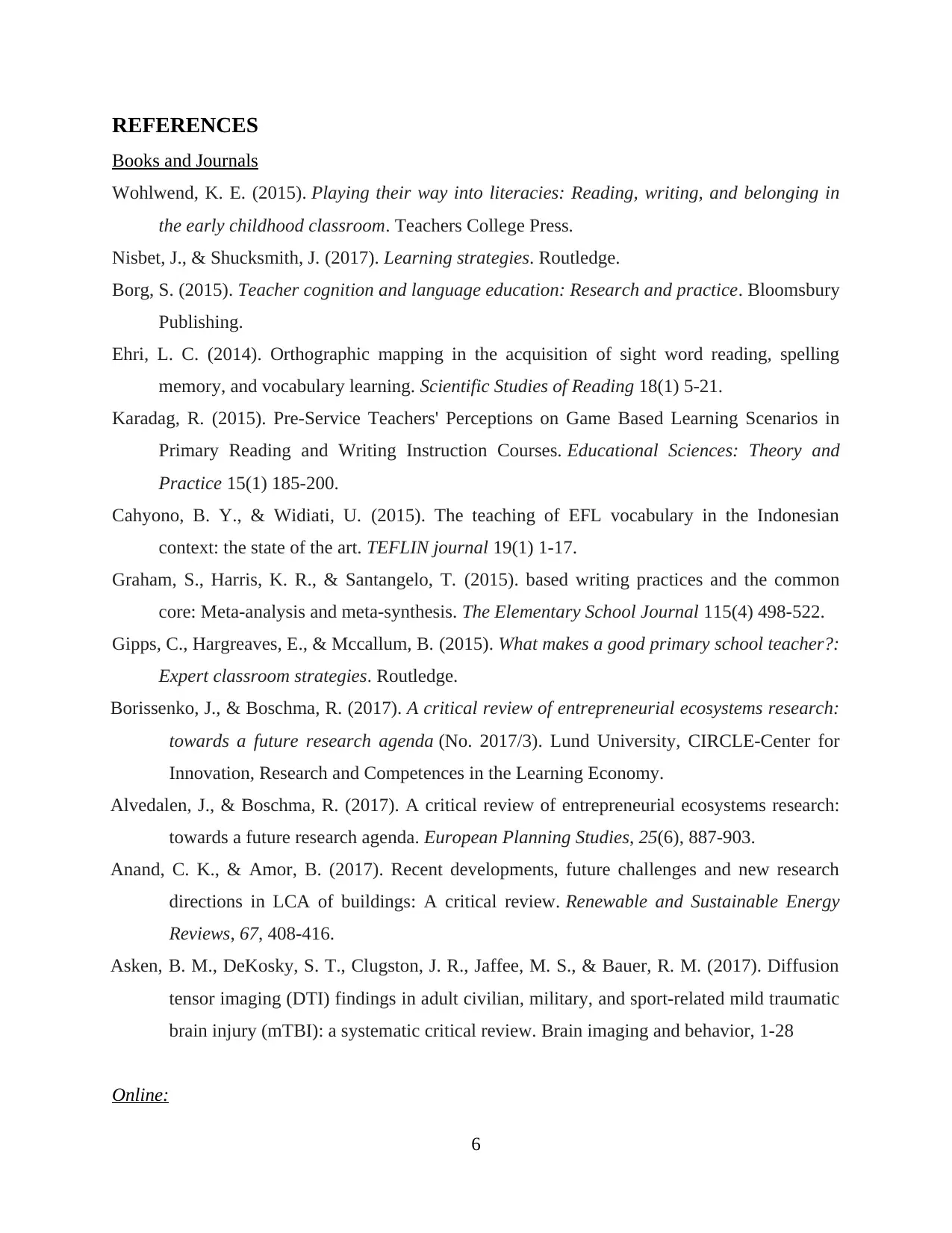
REFERENCES
Books and Journals
Wohlwend, K. E. (2015). Playing their way into literacies: Reading, writing, and belonging in
the early childhood classroom. Teachers College Press.
Nisbet, J., & Shucksmith, J. (2017). Learning strategies. Routledge.
Borg, S. (2015). Teacher cognition and language education: Research and practice. Bloomsbury
Publishing.
Ehri, L. C. (2014). Orthographic mapping in the acquisition of sight word reading, spelling
memory, and vocabulary learning. Scientific Studies of Reading 18(1) 5-21.
Karadag, R. (2015). Pre-Service Teachers' Perceptions on Game Based Learning Scenarios in
Primary Reading and Writing Instruction Courses. Educational Sciences: Theory and
Practice 15(1) 185-200.
Cahyono, B. Y., & Widiati, U. (2015). The teaching of EFL vocabulary in the Indonesian
context: the state of the art. TEFLIN journal 19(1) 1-17.
Graham, S., Harris, K. R., & Santangelo, T. (2015). based writing practices and the common
core: Meta-analysis and meta-synthesis. The Elementary School Journal 115(4) 498-522.
Gipps, C., Hargreaves, E., & Mccallum, B. (2015). What makes a good primary school teacher?:
Expert classroom strategies. Routledge.
Borissenko, J., & Boschma, R. (2017). A critical review of entrepreneurial ecosystems research:
towards a future research agenda (No. 2017/3). Lund University, CIRCLE-Center for
Innovation, Research and Competences in the Learning Economy.
Alvedalen, J., & Boschma, R. (2017). A critical review of entrepreneurial ecosystems research:
towards a future research agenda. European Planning Studies, 25(6), 887-903.
Anand, C. K., & Amor, B. (2017). Recent developments, future challenges and new research
directions in LCA of buildings: A critical review. Renewable and Sustainable Energy
Reviews, 67, 408-416.
Asken, B. M., DeKosky, S. T., Clugston, J. R., Jaffee, M. S., & Bauer, R. M. (2017). Diffusion
tensor imaging (DTI) findings in adult civilian, military, and sport-related mild traumatic
brain injury (mTBI): a systematic critical review. Brain imaging and behavior, 1-28
Online:
6
Books and Journals
Wohlwend, K. E. (2015). Playing their way into literacies: Reading, writing, and belonging in
the early childhood classroom. Teachers College Press.
Nisbet, J., & Shucksmith, J. (2017). Learning strategies. Routledge.
Borg, S. (2015). Teacher cognition and language education: Research and practice. Bloomsbury
Publishing.
Ehri, L. C. (2014). Orthographic mapping in the acquisition of sight word reading, spelling
memory, and vocabulary learning. Scientific Studies of Reading 18(1) 5-21.
Karadag, R. (2015). Pre-Service Teachers' Perceptions on Game Based Learning Scenarios in
Primary Reading and Writing Instruction Courses. Educational Sciences: Theory and
Practice 15(1) 185-200.
Cahyono, B. Y., & Widiati, U. (2015). The teaching of EFL vocabulary in the Indonesian
context: the state of the art. TEFLIN journal 19(1) 1-17.
Graham, S., Harris, K. R., & Santangelo, T. (2015). based writing practices and the common
core: Meta-analysis and meta-synthesis. The Elementary School Journal 115(4) 498-522.
Gipps, C., Hargreaves, E., & Mccallum, B. (2015). What makes a good primary school teacher?:
Expert classroom strategies. Routledge.
Borissenko, J., & Boschma, R. (2017). A critical review of entrepreneurial ecosystems research:
towards a future research agenda (No. 2017/3). Lund University, CIRCLE-Center for
Innovation, Research and Competences in the Learning Economy.
Alvedalen, J., & Boschma, R. (2017). A critical review of entrepreneurial ecosystems research:
towards a future research agenda. European Planning Studies, 25(6), 887-903.
Anand, C. K., & Amor, B. (2017). Recent developments, future challenges and new research
directions in LCA of buildings: A critical review. Renewable and Sustainable Energy
Reviews, 67, 408-416.
Asken, B. M., DeKosky, S. T., Clugston, J. R., Jaffee, M. S., & Bauer, R. M. (2017). Diffusion
tensor imaging (DTI) findings in adult civilian, military, and sport-related mild traumatic
brain injury (mTBI): a systematic critical review. Brain imaging and behavior, 1-28
Online:
6
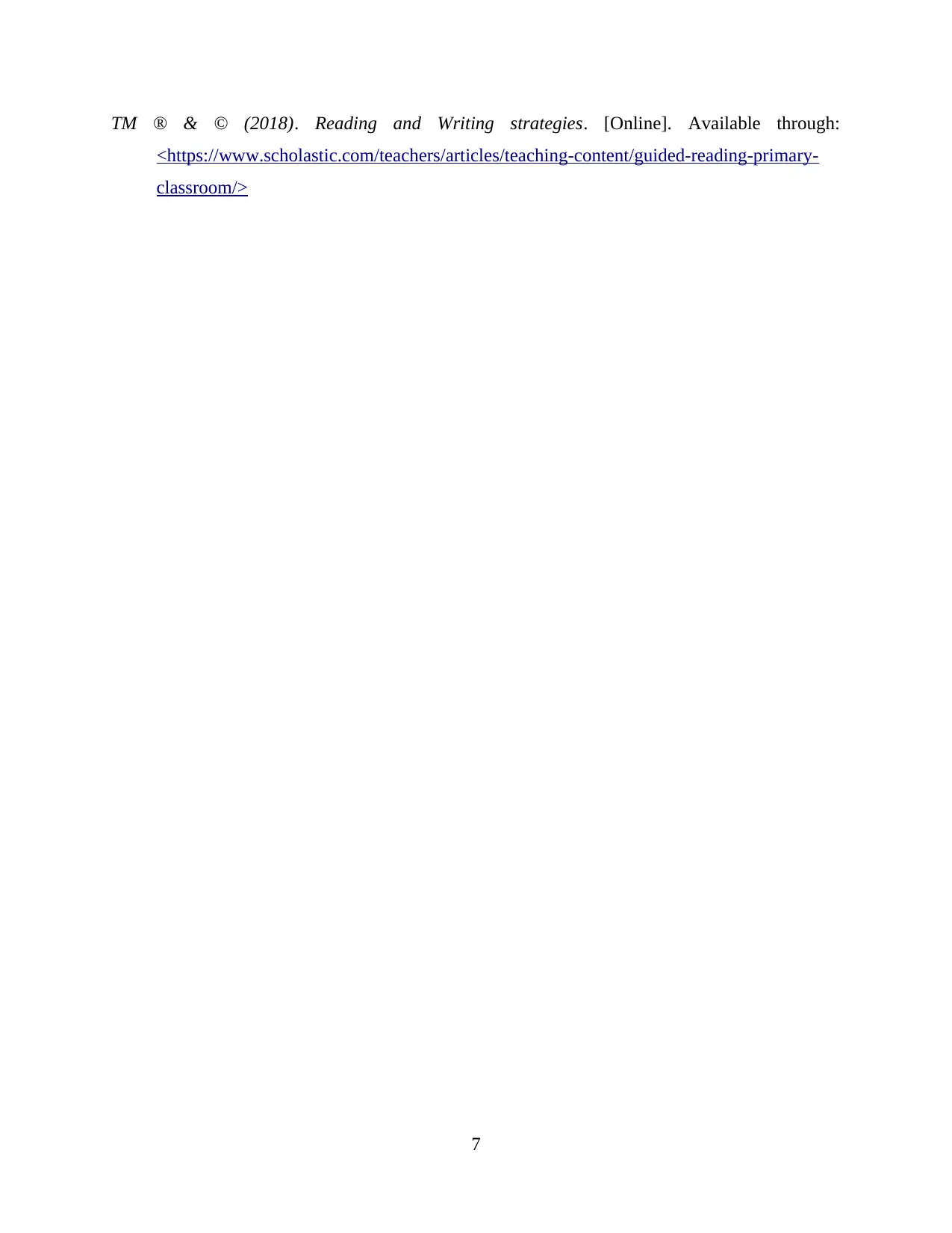
TM ® & © (2018). Reading and Writing strategies. [Online]. Available through:
<https://www.scholastic.com/teachers/articles/teaching-content/guided-reading-primary-
classroom/>
7
<https://www.scholastic.com/teachers/articles/teaching-content/guided-reading-primary-
classroom/>
7
⊘ This is a preview!⊘
Do you want full access?
Subscribe today to unlock all pages.

Trusted by 1+ million students worldwide
1 out of 9
Related Documents
Your All-in-One AI-Powered Toolkit for Academic Success.
+13062052269
info@desklib.com
Available 24*7 on WhatsApp / Email
![[object Object]](/_next/static/media/star-bottom.7253800d.svg)
Unlock your academic potential
Copyright © 2020–2025 A2Z Services. All Rights Reserved. Developed and managed by ZUCOL.





